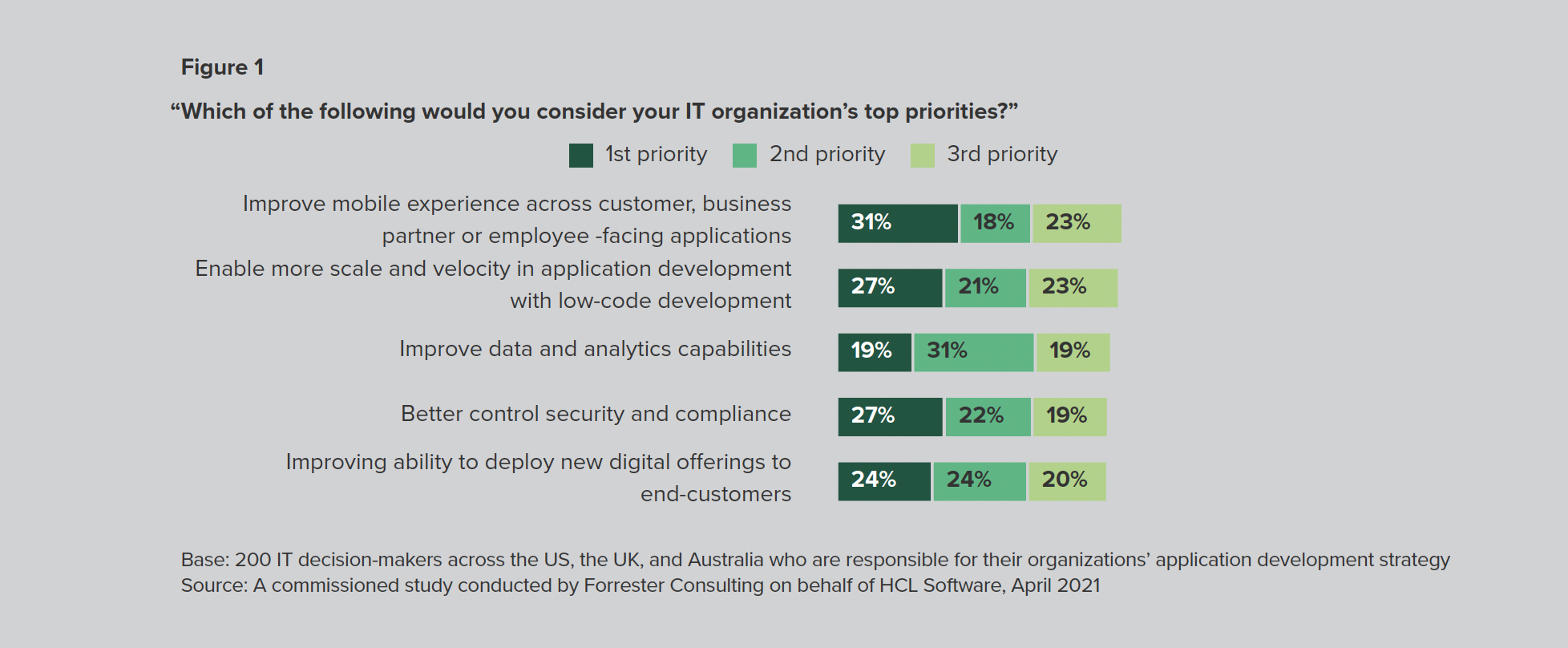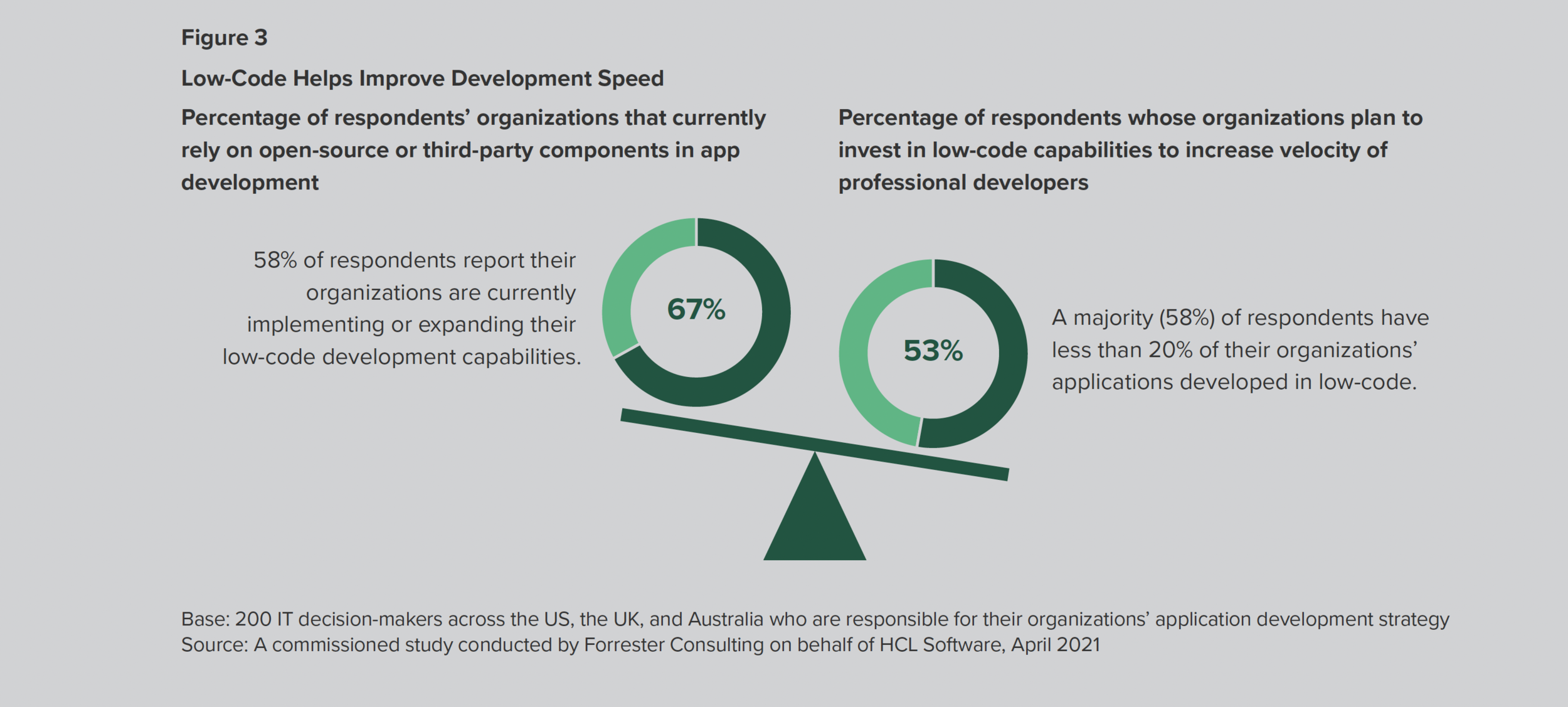
VOLT MX
White Paper
A Forrester Consulting Thought Leadership Paper Commissioned By HCL - July 2021
Leveraging Low-Code Development For Your Innovation Needs
Executive Summary
Innovative mobile application experiences are critical to customer engagement. Digital solutions must provide differentiated customer experiences, while also enabling more collaborative and efficient ways of working internally. Thus, companies must build effective application delivery and development capabilities that enable innovation and address rising customer expectations. Customers want the ability to interact with the business across multiple touchpoints (web, mobile, digital) in a seamless and consistent manner. Mobile application development becomes a key gateway for enabling this multi-experience.
As IT and business decision-makers consider mobile application delivery, low-code development platforms bring significant benefits. Low-code platforms make development more intuitive, flexible, and effective. To respond to rapidly changing customer expectations and business needs, such as the COVID-19 pandemic, firms need to embrace speed, composability, and adaptability in their application experience design. Low-code development can help in this journey.
HCL Software commissioned Forrester Consulting to explore the emerging role of low-code development amid broader application development and delivery priorities and challenges that organizations face. Forrester conducted an online survey with 200 IT and business decision-makers across the US, the UK, and Australia to explore this topic. Through this research, we found that organizations have acknowledged the purpose of low-code development in improving their mobile experiences, but still require focus to apply low-code strategically.
KEY FINDINGS
Organisations recognise the potential impact of low-code capabilities on mobile innovation priorities. Improving mobile experiences is a significant priority for over 72% of decision-makers surveyed, and 68% of these respondents consider low-code development as key to increasing the scale and velocity of their mobile application needs.
There’s further potential for growth in low-code adoption. Fifty-eight percent of respondents reported that their organisations are currently implementing or expanding their low-code development capabilities. However, this majority also acknowledges that less than 20% of their organisations’ applications are developed in low-code, suggesting the organisations are in an early stage of low-code implementation.
Low-code has the potential to further adoption, especially for mobile development. An average of 52% of respondents stated their organisations plan to increase their use of low-code development over the next two to five years.
Customer-Driven Innovation Enables A Rise In Low-Code Development Approach
With application delivery and development capabilities remaining pivotal to organizations’ innovation strategy, surveyed decision-makers highlighted the importance of low-code in their organizations’ mobile application needs.
Mobile innovation is a key business driver for organizations. Seventyeight percent of respondents indicated a priority to innovate and improve their organizations’ access to customers with 80% considering mobile touchpoints as a key enabler of innovation and customer engagement (see Figure 2). IT priorities align to these needs with 72% wanting to improve mobile experience across customer, business partner, and employee-facing applications (see Figure 1).
Quickly differentiating digital offerings at scale is key to customer engagement. According to 68% of survey respondents, a focus of innovation is to differentiate digital offerings. Also, 69% of respondents reported their organizations expect to improve the scale and speed of how they develop and improve their business applications. This ability is a key IT priority over the near-term.
Organizations see low-code as a top priority. With scale, speed, and mobile-based innovation deemed important, 68% of decision-makers considered low-code development as part of their top three IT priorities, because low-code enables increased speed and scale for developers.
68% of respondents consider low-code development one of their organizations’ top 3 IT priorities.
Organizations Take A Strategic Approach To Low-Code Development
Firms show the potential to further leverage low-code capabilities. A majority (67%) of respondents reported that their firms currently rely on open-source software or third-party components in app development (see Figure 3). Fifty-three percent of respondents reported their organizations are specifically investing in low-code capabilities in the near-term to increase velocity of professional developers. Low-code development is currently being implemented or expanded by 58% of survey respondents’ organizations. A majority (58%) still have less than 20% of their organizations’ applications developed in low-code, though, showing potential for further adoption across the application portfolio.
Decision-makers look to low-code to improve productivity and speed. Eight-two percent of respondents considered improving capabilities and productivity of developers as a key driver for lowcode investment, while 77% considered the speed of deployment with low-code to be a critical driver (see Figure 4). Seventy three percent of decision-makers also reported that their organizations found multiexperience management an important driver for low-code, as enabling more intuitive developer capabilities would allow developers to build application experiences across a variety of channels, such as digital, wearables, augmented reality, and more.
Organizations want low-code to play a greater role in both internal and external application needs. Currently, 13% of respondents reported their organizations developing customer-facing mobile applications with low-code capabilities. Eleven percent of respondents reported their firms using low-code for enterprise-wide applications. This highlights the equal bearing low-code development’s capabilities can have on both internal and external-facing applications, supporting the reasoning behind 53% of respondents who reported their organizations are looking to further increase their low-code development capabilities over the next two to five years.





